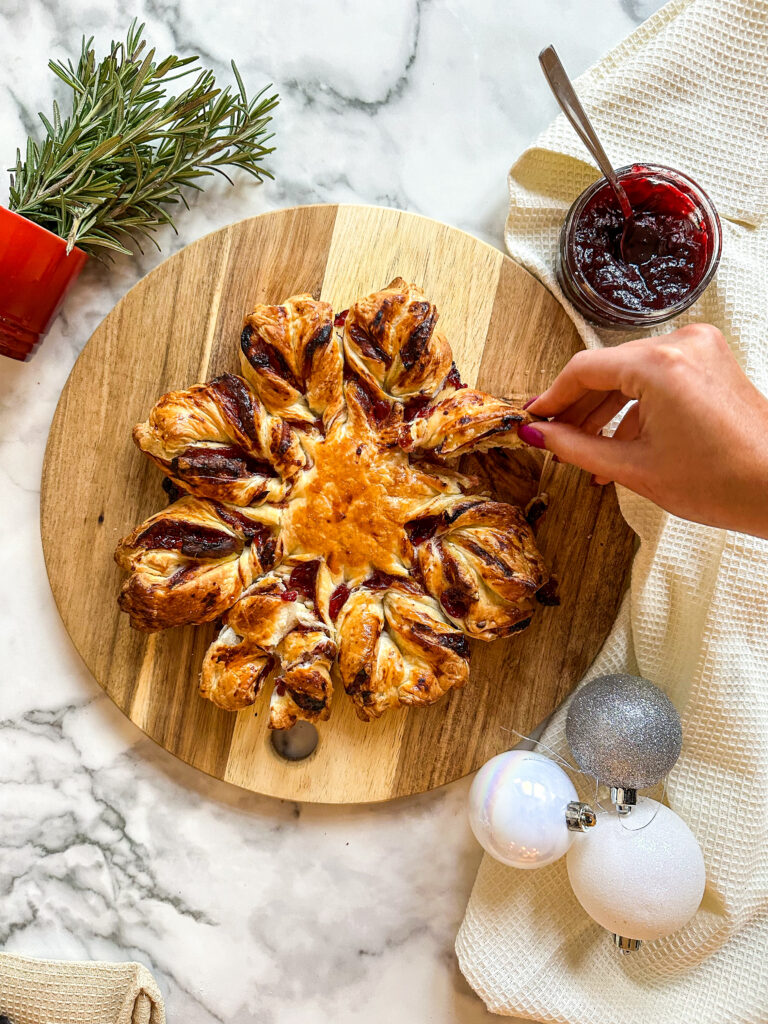This Brie, Rosemary and Honey Focaccia is such a delightful bread to bake and serve. The little rounds of brie look so cute and give a little flavor bomb to the bread. Add some rosemary and brush with honey for some complexity. This works really well served up on a cheese board, as a side to a hearty Italian dinner, or use it to make pretty epic sandwiches (I’m thinking parma ham, sun-dried tomatoes, spinach – the works).
Focaccia is the type of bread that is so impressive to others but actually isn’t too complex. It is super versatile so feel free to play with other toppings! This came about from a massive love of cheese and wanting a side to go with a tomato pasta dish. I highly recommend using fresh rosemary, but dried is fine if you can’t find away! Likewise with good quality extra virgin olive oil, it makes a difference but I recognise this can come at a cost.
Allow yourself a good amount of time for this, as there are two proofs. Additionally, adding in time between folds really lends itself to a great textured dough. That said the actual hands on time isn’t too much. You can set it aside and come back to it. A little bit of a labor of love, but I promise with all my heart, it is worth it! The kneading process is good fun if doing by hand. I like to use it as an opportunity to really work out some stress, and it always makes me feel like “a real baker”. Finding an easy focaccia recipe can be hard, but I hope this lays out the steps with so much ease that you find yourself wanting to make it time and time again.
Some Guidance for Great Focaccia
When it comes to making great focaccia, a few key tips can help you elevate this simple yet delicious Italian bread to the next level. Here is a breakdown to consider incorporating into your baking practice:
- Choose The Right Flour: For authentic focaccia, strong bread flour is ideal because it’s high in gluten, allowing the dough to stretch and trap air bubbles for a light and airy texture.
- Hydration is Key: A focaccia dough should be relatively wet and sticky. A higher hydration (around 75% water to flour ratio) is what gives focaccia its characteristic crumb.
- Proper Olive Oil Usage: Generously anoint the dough with good quality extra virgin olive oil before the final proof and again right before baking to achieve a crispy, flavorful crust and moist interior.
- Salt is Your Friend: Don’t skimp on salt. It’s crucial for flavor. Sprinkle coarse sea salt on top before baking, but also make sure your dough is adequately seasoned.
- Gentle with the Dough: Handle the dough gently to keep air pockets intact. When dimpling the dough before the final proof, be gentle and consistent to create the characteristic pockmarks without deflating the dough.
- Even Heat Distribution: A hot oven and a preheated baking surface, like a pizza stone or a heavy baking tray, helps the focaccia to cook evenly and get a good rise.
- Consider Toppings: Rosemary and sea salt are traditional, but don’t be afraid to experiment with other herbs, caramelized onions, olives, sun-dried tomatoes, or cheeses for variety. In this, I use a long stick of Brie, but any shape or similar soft cheese work well. Similarly, use another cheese or any toppings you love.
- Watch the Baking Time: Bake until it’s golden brown on top, but start checking a few minutes before the recipe suggests, as oven temperatures can vary.
- After Baking: Don’t rush to cut into it. Let the focaccia rest for a few minutes after baking so the crumb structure sets and the bread retains its moisture.
By following these tips, you’ll be closer to achieving a gorgeous focaccia with a bubbly texture and rich flavor that can only come from homemade baking efforts.
Ingredients for this recipe:
- Strong White Bread Flour
- Dried Fast Acting Yeast
- Warm Water
- Salt
- Olive Oil
- Brie
- Fresh Rosemary
- Honey

Tips for the best Brie, Rosemary and Honey Focaccia
- Yeast: If your yeast has sat in the cupboard a while, you may want to make sure your yeast is active. Do this by combining with the warm water, then leave for 10 mins. If the mixture is bubbly, it is active. If not, throw it out and get new yeast!
- Kneading: You can use a dough hook attachment with a mixer for 8 minutes, or by hand for 10 minutes. This stretches the gluten helping to give that bubbly, fluffy texture! Hand-kneading is excellent for getting out some stress, but they give the same result regardless.
- Olive Oil: As mentioned, a high quality olive oil is best but not totally game-changing if this is out of your budget! Extra virgin olive oil is your best bet, but of course, use what works for you.
- Cheese/Herbs: This recipe uses brie and rosemary, but use what you love. Change the brie for camembert or another soft cheese. Dried herbs are fine if fresh rosemary is hard to find. Make the bake work for you!
- Honey: Once again, use what you have. Try to avoid overly floral or flavored honey as I find these compete too much with the flavors already present in the dough.
- Resting: The proves are crucial to the structure. Try to let the dough double in size for the first prove. The second prove is less about growth and more about rest. Don’t stress if it doesn’t drastically ‘grow’ in this phase.

Brie, Rosemary and Honey Focaccia
Ingredients
- 7 g Dried Fast Acting Yeast
- 525 g Strong White Bread Flour
- 6 tbsp Extra Virgin Olive Oil
- 3 tsp Salt
- 350 ml Warm Water
- 170 g Brie I use a Brie Log
- 2 tbsp Honey
- Fresh Rosemary A few sprigs
Instructions
- In a large bowl, or the bowl of a stand mixer, add the flour and yeast and combine. Add in the salt and combine again.
- Make a well, pour in 3 tbsp Olive Oil and about 350ml warm water (not hot). Combine to form a dough. It should come together but be pretty sticky. If not, add more water.
- Knead using the dough hook attachment or your hands on a lightly floured work surface for about 8 minutes (it should be soft, smooth but still sticky). Oil the bowl you used for the dough, place the dough back in it, cover with a tea towel and let rest for an hour – until doubled in size.
- Punch the dough down and we're going to "fold" it. Pick up one side of the dough, stretch it up and fold over onto the rest of the dough. Rotate the bowl 90 degrees and repeat 3 more times. Let rest 30 minutes. Repeat, letting rest another 30 minutes before starting the next step.
- Pre-heat the oven to 225℃/450℉. Generously drizzle oil over a 9 inch square pan.
- Tip the dough into the pan, pushing gently to the edge. Dimple by pressing your fingertips into the dough, working at an angle to form those classic bubbles.
- Slice your brie and place on top of the dough. Let rest while the oven heats up.
- Bake for 20 minutes – until the top looks golden and crispy.
- After removing from the oven, but while still warm, brush with more oil and the honey. Top with fresh rosemary. Let cool before serving.
I make this Brie, Rosemary and Honey Focaccia in a 9 inch square tin. I recommend a high speed mixer with a dough hook attachment to do lots of the kneading work (this is what I use and am in love with). For more savoury baking, check out this Pesto and Cheese Swirl Bread. For more baking inspiration and videos, head on over to my Instagram.
Storage
Storing homemade focaccia correctly is essential to maintain its freshness and flavor. Here’s a guide on how to do it:
At Room Temperature
- Cool Completely: Allow your focaccia to cool to room temperature after baking. Do not cover it while it’s still warm, as the trapped steam can make the crust soggy.
- Wrap Properly: Once cool, wrap the focaccia in aluminum foil or plastic wrap. This will help to keep it moist.
- Store in a Bread Box or Paper Bag: Place the wrapped focaccia in a bread box or paper bag to allow for some air circulation while keeping it out of direct sunlight and away from heat sources.
- Consume Within 2 Days: Ideally, consume the focaccia within 1-2 days while it’s still at its freshest.
Refrigerating Your Focaccia
- Wrap Well: Use cling film or aluminum foil to wrap your focaccia tightly, which will help to preserve moisture.
- Seal in a Bag: Place the wrapped bread into a sealable plastic bag to avoid absorbing other food odors.
- Use Within 4-5 Days: Refrigerated focaccia should be consumed within 4-5 days. To serve, reheat in the oven to recrisp the crust.
Freezing for Long-Term Storage
- Slice if Preferred: If you plan on eating small amounts at a time, slice the focaccia before freezing.
- Wrap in Foil or Freezer Wrap: Wrap the bread in two layers of aluminum foil or use a heavy-duty freezer wrap.
- Place in Freezer Bag: To protect against freezer burn, place the wrapped focaccia in a freezer bag and squeeze out as much air as possible before sealing.
- Label and Freeze: Write the date on the bag. Properly stored, frozen focaccia can last for up to 3 months.
- Thaw and Reheat: Thaw at room temperature or in the refrigerator. Reheat in the oven at 350 degrees Fahrenheit until warm and the crust is crispy again.
By following these steps, you can ensure that your homemade Brie, Rosemary and Honey Focaccia remains delicious long after it comes out of the oven.












